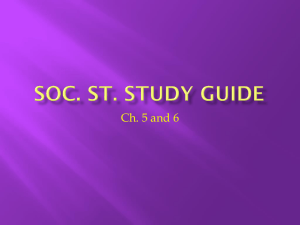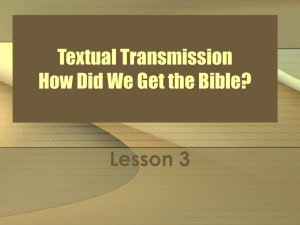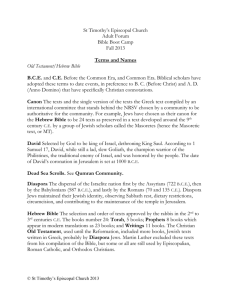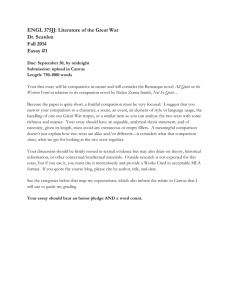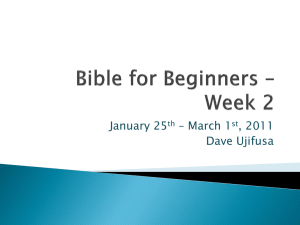LA 1009 Athens and Jerusalem outline 15-16
advertisement
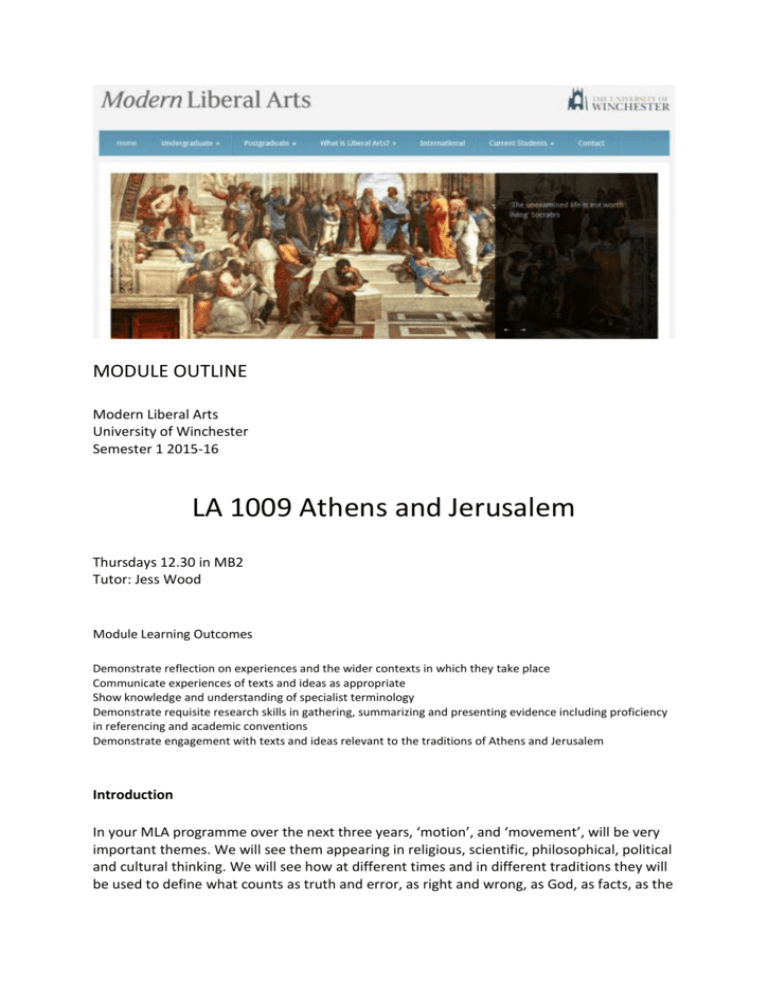
MODULE OUTLINE Modern Liberal Arts University of Winchester Semester 1 2015-16 LA 1009 Athens and Jerusalem Thursdays 12.30 in MB2 Tutor: Jess Wood Module Learning Outcomes Demonstrate reflection on experiences and the wider contexts in which they take place Communicate experiences of texts and ideas as appropriate Show knowledge and understanding of specialist terminology Demonstrate requisite research skills in gathering, summarizing and presenting evidence including proficiency in referencing and academic conventions Demonstrate engagement with texts and ideas relevant to the traditions of Athens and Jerusalem Introduction In your MLA programme over the next three years, ‘motion’, and ‘movement’, will be very important themes. We will see them appearing in religious, scientific, philosophical, political and cultural thinking. We will see how at different times and in different traditions they will be used to define what counts as truth and error, as right and wrong, as God, as facts, as the critique of identity, and as protest, resistance and change. It is impossible to overestimate how important motion and movement are in the ways that meaning is constructed in the world. You will see many movements between this module and First Principles, and in Freedom is to Learn (a) and (b), in semesters 1 and 2. We are keen for you to bring material ‘across’ the module even in the second essay. In this module, and right at the beginning of the programme, it seems appropriate to consider the meaning of movement between what is defined as the ‘Eternal’ and what is defined as the merely ‘human’. To explore the relationship between them, we will look at how various traditions have thought that the two spheres can relate to each other. The movements which operate this relation are down, up and across. Down refer to the descent of the Eternal into the earthly, or into finite time; up refers to ideas like transfiguration in which human beings are raised to the Eternal; and across… well, let’s wait and see what part this plays in the relation between up and down. Weekly sessions Weekly sessions First 6 sessions: Weaving Eternity into Time: the Descent of the Eternal Introduction: In other modules in Year One, you will spend a great deal of time in Athens, and the ancient Greek tradition. By way of contrast, in this module, we journey to Jerusalem. In the first 6 sessions we will trace the descent of the Eternal into History by exploring the text at the heart of the Jewish tradition, the Hebrew Bible. Week 1 In between heaven and earth Jacob’s Dream: And he dreamed, and behold a ladder set up on the earth, and the top of it reached to heaven: and behold the angels of God ascending and descending on it [Gen.28.12]. Jesus to Nathaniel: Truly, truly, I say to you, you will see the heavens opened and the angels of God ascending and descending on the Son of Man [John 1.51]. Krishna to Arjuna: I come in to being age after age [B-G 4.8] Heaven meets earth in people. Some of these people are climbing up the ladder in between, some have come down. An introduction to the two-part module, unraveling the key concepts and themes of divine descent (incarnation) and human ascent (transfiguration) and the relation between saints, heroes, self-sacrifice and transcendence. Reading: Handout 1: Underlying Principles Handout 2: Standpoint Hebrew Bible (Christian: ‘Old Testament’): Genesis chapter 28 (Jewish Publication Society or RSV or AV versions) New Testament Gospel according to John chapter 1 and 11 (RSV or AV versions) Bhagavad-Gita Chapter 4 (Oxford World Classics, OUP, 2004) Week 2 Jewish and Christian creation stories Heaven meets earth in nature. We shall explore the two Creation stories in Genesis and look at the interpretive method called PARDES (the fours layer of meaning to be unearthed in the text through creative exploration). We shall learn about the Hebrew Bible. Why do Christians still call it the ‘Old Testament’? Reading: Handout: PARDES Handout: Introduction to the Bible Hebrew Bible (Christian: ‘Old Testament’): Genesis Chapter 1-2 (Jewish Publication Society or RSV or AV versions) Additional Reading: Sarah, Rabbi E. Trouble-Making Judaism Part One, chapter 1 (David Paul Books, London, 2012) – Extracts Week 3 Creation stories: ancient and contemporary We will examine the creation stories of the Near Middle East which parallel Genesis and also use Australian Aboriginal creation stories to compare and contrast with the Hebrew Bible. Reading: Reed, A.W Aboriginal Stories of Australia (Reed New Holland 1998) Heidel, A. The Babylonian Genesis (Phoenix Books 2003) Hesiod, Theogony and Works and Days (Oxford World Classics 2008) Week 4 The Deluge: ancient flood Stories George, A. Epic of Gilgamesh (Penguin 2003) Heidel, A. The Gilgamesh Epic and Old Testament Parallels (University of Chicago Press 1949)) Hebrew Bible (Christian: ‘Old Testament’): Genesis Chapter 6-9 Week 5 Divine manifestations: burning bush and pillar of fire How is the Eternal present on earth? We shall explore all those stories in the Hebrew Bible where the Eternal appear in a seemingly ‘physical’/ embodied way (a voice ‘walking’, a burning bush, lightening, cloud, fire, ruach – wind). How do these embodiments compromise the Oneness of the Eternal? Do they pre-figure the Christian doctrine of incarnation? Reading: Hebrew Bible and Midrash: Genesis and Exodus Sarah, Rabbi E. Encountering the Eternal: Beyond the Tyrannical Dictator and Towards the Elusive (unpublished essay 2014) - Extracts Week 6 Putting the Eternal in a box: the ark, tent of meeting and temple We will explore the Jewish concept of midbar (wilderness/desert/emptiness) and mishkan (dwelling place/sanctuary) as places of encounter and meeting, using the Biblical texts and commentaries: a) The Eternal is vividly portrayed in the Hebrew Bible in series of sacred encounters b) the people create sacred spaces to ‘hold’ these encounters:, standing stones in high places, the sacred box (ark), the portable Tent of Meeting and the Temple. Reading: Hebrew Bible: Genesis Chapter 28, Exodus Chapter 3, 15, 16, 17, 19, 25, 29, 40; I Chronicles Chapter 28; I Kings Chapter 8 Additional reading: Cadman, D. & Carey, J. Sanctuary (Temenos 2006) Lundquist, J.M. The Temple (T&H London 1993) Handout: Church floor plans Burckhardt, T. Sacred Art in East and West: The Genesis of the Hindu Temple (Perennial Books 1986) Second six sessions: The Ascent of the Human: the Self-Transfigured Introduction: In the second half of the module we will look at the ascent, as it were, of the human into the Eternal. Looking at history through biography we will view huge movements and key moments in history through the prism of the lives of a few extraordinary individuals. Week 7 Anti-heroes: Moses and Jesus the Jew Moses and Jesus the two foundational figures in Judaism and Christianity are portrayed in as transgressors. We study their representations in Hebrew Bible and Christian gospels and focus on Jesus the Outsider and Jew. Reading: Hebrew Bible: Exodus Chapter 2-4 (Jewish Publication Society or RSV or AV versions) Kierkegaard, S. Attack Upon ‘Christendom’ [on-line edition of Ed. Lowrie, W. University of Princeton Press 1946] Handout: Jesus the Jew – extracts from gospel, according to Matthew Wood, J. Jesus Post-Christianity (unpublished teaching handbook) – extracts Vermes, G. Christian Beginnings (Penguin 2003) Week 8 Wild imaginings: Christa and St Wilgefortis How is the Risen ‘Lord’ be ungendered/re-gendered? We explore contemporary images of the Christa and medieval images of a bearded woman, crucified. Friesen, I.E. The female Crucifix: Images of St Wilgefortis (Wilfrid Laurier University Press 2001) Slee, N. Seeking the Risen Christa (SPCK 2011) Week 9 Trans and gender in the Hebrew Bible Using an essay by Rabbi Elli Sarah, and an in-depth Biblical study of the tales of the Special One, Joseph and the female prophet, Deborah, we discover how the Bible uses narratives to express how the Eternal relates to the human. We will explore how contemporary feminist theologians re-interrogate the texts to reveal proto-trans and feminist themes. Reading: Hebrew Bible: Genesis Chapter 37(f) and Judges Chapter 4 Sarah, Rabbi E. Joseph the Beautiful Dreamer: another way of being male (unpublished essay 2014) - Extracts Sarah, Rabbi E. Deborah the Prophet and Judge: another way of being female (unpublished essay 2014) – Extracts Additional Reading: Wilchins, R. Queer Theory, Gender Theory (Alyson Publications, 2004) – Extracts Adler, R. Rabbi Engendering Judaism (Beacon Press 1999) Week 10 Holy Women: Mary (and Hannah) and Miriam Mary (and Hannah) and Miriam: What is the place of the Leading Women in the Bible? We will explore the texts and search out a feminist reading. Reading: New Testament: Matthew Chapter 1 and Luke Chapter 2 Handout: Infancy Narratives – Mary Hebrew Bible: Miriam: Exodus and Numbers; Hannah: Samuel Chapter 1-2 Sarah, Rabbi E. Trouble-Making Judaism Part One, chapter 2 (David Paul Books, London, 2012) – Extracts Meir, T. Miriam: Midrash and Aggadah http://jwa.org/encyclopedia/article/miriammidrash-and-aggadahMiriam: Midrash and Aggadah Winter, M.T. The Gospel According to Mary: A New Testament for Women (Crossroad Publishing Company, New York, 1993). Boss, S.J. Mary: New Century Theology (Continuum, London 2003) Week 11 Saintly ‘transgressors’ 1: Jeanne d’Arc In terms of gender and sexual orientation, we trace how despite social and religious norms, saints are able to integrate the transgressive. Condemned to die, Catholic saint Jeanne d’Arc took off the ‘shift’ the church captors forced her to wear and demand her male clothes back. Burned as a witch – redeemed as a saint. We trace her journey. Reading: Pernoud, R. Joan of Arc (Penguin 1964) Shaw, Bernard Saint Joan (Penguin 2001) Further reading: Sackville-West, V. Saint Joan of Arc (Michael Joseph, London 1936) Week 12 Saintly ‘transgressors’ 2: Rumi The Sufi Master and poet, Rumi, passionately loved his friend and Teacher, Shams. Out of this love, he developed an inclusive mysticism which broke the spiritual boundaries of his time and ours. Reading: Hebrew Bible: Song of Songs Barks, C. and Moyne, J. The Essential Rumi (Penguin, London 1995) Barks, C. Rumi - The Book of Love (Harper One USA, 2003) Burckhardt, T. Introduction to Sufi Doctrine (World Wisdom 2008) chapters 1, 4, and 8. Assessment Assessment 1: (50%) Using materials from weeks 1-6, describe ideas of the descent of the Eternal (1750-2000 words; deadline: Week 7 (Thursday 5th November) given to Catherine in the Office by 3.30pm). Assessment 2: (50%) Choose a title from one of the following: What is a transgressive saint? What is the relation between transgressive saints and anti-heroes? What do you understand by the descent of the Eternal and the ascent of the human? (1750-2000 words; deadline (Week 1 semester 2 (Thursday 14th January) given to Catherine in the Office by 3.30pm). Use Harvard Referencing We attempt always to return work within 3 working weeks (15 days working days). MODERN LIBERAL ARTS MARK SCHEME We want you to be very clear about how we will mark your work and that means you must know with each assessment what you are expected to do. We hope that this does not mean you will feel that you have to write to a formula. We are trying to build in considerable freedom to your assessments; but as the term ‘liberal arts’ conveys, in every freedom there is a discipline, and in every discipline there is a freedom; together, we hope, they constitute the struggle of learning. There are (often but not always) two types of essays in MLA: the first assessment title in a module will most often be set by the tutor and will be restricted to texts explored in the first weeks. The second assessment title can be tutor-led, or chosen from a list of titles, or can be negotiated individually; this varies according to the tutor and the module. This assignment can explore wider issues, employ wider reading, or explore a single issue in depth. Students will bear some responsibility for the references consulted in the second essay, increasing through years 1, 2 and 3. Tutor-set assessments (disciplina) Student/tutor-set assessments (libertas) 1st module essay 2nd module essay Marks for depth of understanding specialist terminology depth of understanding of set texts Marks for depth of understanding of texts depth of understanding and application of ideas/concepts depth of understanding of ideas/concepts evidence by quotation answering the question correct referencing word limit evidence-based critical arguments depth/breadth of reading (depending on the question) answering your own question correct referencing word limit Note the difference between essays 1 and 2: the first one is marked only on your understanding of texts; the second one is marked on understanding, on your own reading, and your emerging critical voice. Be careful here; being critical does not mean just giving your opinions. It means making a case based on evidence from your reading, using ideas and concepts from texts. It does not mean you have to fight for one side of an argument or another… ambivalence will be treated with great respect. But for every essay, remember this: if we (and you) get the title right, then by answering the question you will be doing exactly what is required. Over years 1, 2 and 3 the levels of your work are raised by using increasingly challenging texts, ideas, concepts and writers, and by the way you are able to employ ideas, concepts and writers from other modules across the degree in increasingly sophisticated ways. For all essays, then Depending on the question you will need to Demonstrate reflection on module material and the wider contexts from across the degree which might impact upon it Communicate experiences of texts and ideas as appropriate Show knowledge and understanding of specialist terminology Demonstrate requisite research skills in gathering, summarizing and presenting evidence including proficiency in referencing and academic conventions. For essay 1 Depending on the question you will need to Show careful reading of primary sources Show a knowledge of theoretical perspectives and/or works Show an understanding of abstract concepts and ideas within theoretical perspectives Show an ability to work with theorists and their concepts in various forms of assessment as appropriate Show evidence of engagement with texts and ideas concerned with issues raised in the module. For essay 2 Depending on the question you will need to Show an ability to employ theorists critically in relation to issues Show an ability to use concepts as critical tools in discussing issues and questions as appropriate Show an ability to employ theoretical perspectives as critical tools Therein, to develop a critical voice informed and deepened by appropriate use of theory as critique. Sustain a critical relationship to ideas related to the module It is often hard to explain in generic terms how any particular essay could have been improved. But, cautiously, we can say the following: In general, a 3rd (40-49%) may have ignored the question, may have not given much evidence of reading, may have clumsy sentence structure, but will still have made a bona fide attempt at the work. a 2.2 (50-59%) will have provided evidence of reading, quotations where appropriate, clear sentence structure, attended to the question or title, but not related the material in ways which synthesise more developed and complex thinking. a 2.1 (60-69%) will have evidence of reading through effective selection of quotation, being able to make specific points, and to relate material together to make broader and/or deeper and more complex observations. At the higher end, it may have been able to relate material from across modules, or across the degree as a whole, to synthesise separate ideas and issues into more holistic comments, ideas and problems. The questions addressed will be getting ever more difficult and important, including those that are asked without being answered. a 1st (70-100%) will make a little go a long way. Quotations may carry implications beyond their precise content; sentences will be clear but able to refine complex ideas succinctly; most importantly, it will be able to combine the microcosm of its subject matter with the macrocosm of its place in the wider context, and these contexts will be drawn form the overall, experience of the degree, growing obviously from years 1 to 3. No inaccuracies of grammar or sentence construction, and no referencing mistakes are expected here. The voice of the essay will be in control of difficult material throughout. Above all the questions asked and addressed will be compelling in their difficulty and import. Module Evaluations (previous year) This was the first time this tutor had taught this module and the module evaluations really were very encouraging and positive indeed. They commented on excellent reading packs, clear and coherent teaching and organisation, a caring and compassionate tutor offering excellent support, both pastoral and academic, and an approach which bred confidence and positivity in the students self-belief. The material, eclectic at times, was commented on as bringing an interesting breadth to the students. One commented that it was fascinating to have a Jewish perspective. Another asked if the module could have an oral component as part of its assessment. This is part of a bigger issue regarding the assessment by learning voice which our revalidation will introduce in the coming year. It is therefore too soon to introduce it into this module, but assessment by learning voice presentation will become part of the degree in one news time. Another evaluation commented that it was hard to find books by Emanuel Levinas. This is a strange comment as the library has a very good stock of Levinas, but the tutor will ensure that students are made aware of this next time. It is intended that this module will be taught for the last time next year, and therefore minimal changes will be introduced at this stage. Catalogue summary The liberal arts are built upon ancient Greek foundations, and have tended to exclude ancient Jewish texts or read them through a Greek lens. This module seeks to redress this by introducing the Jewish voice to create a dialogue. We will explore and contrast the differing world-views of how the world began, how enlightenment is achieved, the path to wisdom, the futility of life and the question of death. We will then experiment with a Jewish approach to the trivium and quadrivium, asking questions like: What does Hebraic astronomy look like? How did ancient Jews view music?

